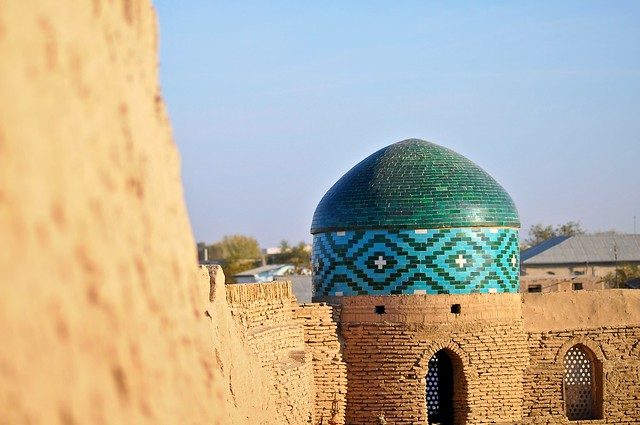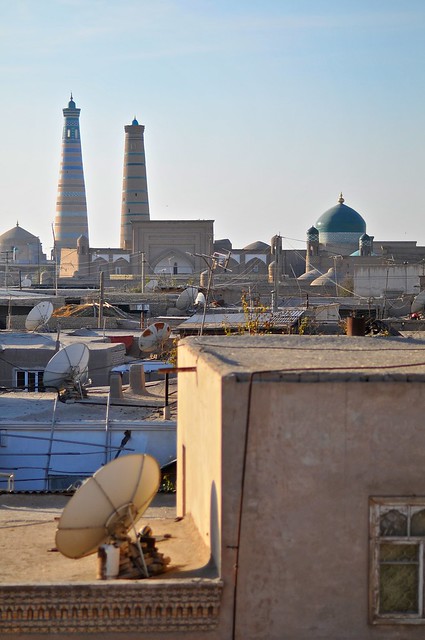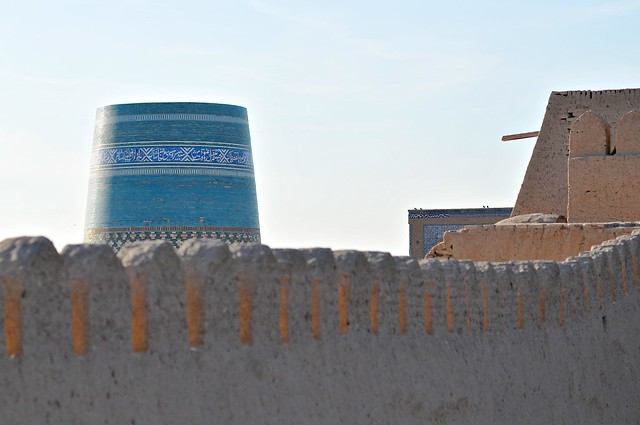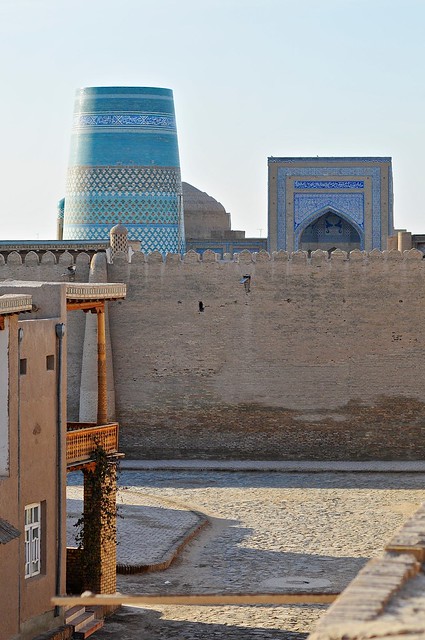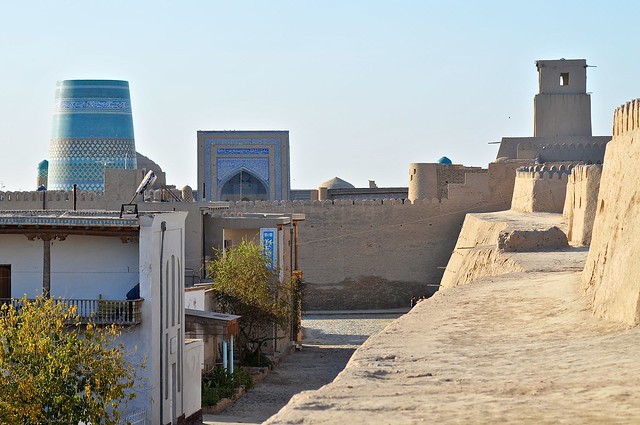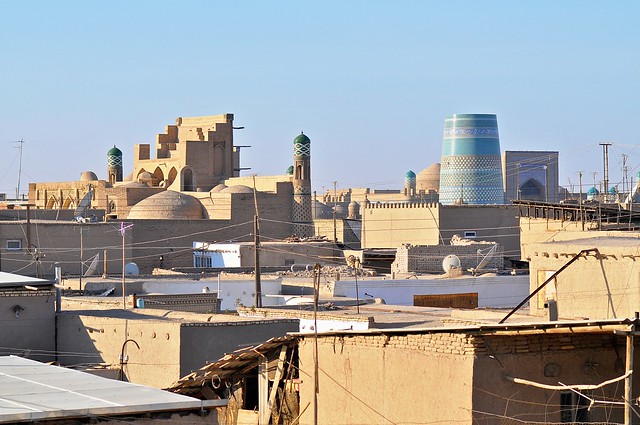From Bukhara to Khiva in 24 annoying hours
Getting from Bukhara to Khiva took one full day, and was not a fun process: far better to take the night train from Samarkand (or Tashkent). Even if you're dumb, like me, and visit Tashkent, Samarkand, and finally Bukhara in geographical sequence, it would still be better to backtrack from Bukhara to Samarkand just to take the night train.The reason I say this is because the road from Bukhara to Urgench is really bad, and in order to take it you'll need to get a ride in a shared taxi. As with other places, getting a shared taxi often isn't fun, and often involves hours of waiting around. For me, the taxi process involved showing up at the bazaar in the morning, negotiating with a driver until we reached a reasonable price, then waiting in the car while he solicited more passenger. Then, after an hour of waiting, he returns to the car with three passengers who want to go somewhere else, so tries to kick me out of the car, while I argue with him for a while and tell him to find me another driver going to Khiva or Urgench for the agreed price. He finally does, after first threatening to run me or my bag over. Then it's another hour waiting for the other car to fill up, followed by a half hour of driving around Bukhara in search of something. I had assumed we were looking for cargo, but after slowly driving past a few fuel stations where no fuel was being pumped but whose long lines of cars—some parked until the station started pumping again, others with driver asleep inside or nearby—at the entrance would make the 1973 oil crisis look minor in comparison, I understood we needed to get some gas. This was followed by us starting our drive outside of town, then the car sputtering to a stop. After a few phone calls, another car shows up and hooks up a rope to tow us. We are then towed not into the city, but into the country, where we were taken to a fuel station that was open for service. There we popped the trunk and filled up the LP tank that so many cars in the region run on.
Finally fueled up and ready for the road, we set off on the bumpy hell-hole of a road (one would think a road through the desert would be fairly easy to maintain, but the potholes and eroded tarmac said otherwise) to Urgench. At about the halfway point we made a stop, and one of the ladies in the back who was traveling with her daughter (they were sharing a seat) asked to change places with me; I was in the coveted front seat, which the first passenger inevitably secures. I was kind of surprised, because everyone knows the front seat is the best and I've never seen it conceded, nor anyone ask for it if someone else was in it, but I relented and got to be squeezed in the back.
Between the time spent waiting, the time spent getting fuel, and the poor road, it was well after dark when we pulled into Urgench, and were deposited just north of the train station (a brand new and gleaming facility, though they don't get many trains out there). A bus pulled in at about the same time, and there were some taxis milling around. Not many were going to Khiva, which is about 35km away, but one woman who was going there teamed up with a driver to try and scam me. Well, really she's the one who tried to scam me, saying that we could split the cost of the car to Khiva, and that if we each paid 25,000 sum we could leave immediately. This was half as much as I had paid from Bukhara (which is over ten times further, on worse roads), and although she insisted she would have to pay the driver just as much (which he confirmed), it was clear that I would be paying for more than the car would cost and she would take a cut of the money after pretending to pay the driver. Oh, Uzbekistan, how predictable you're getting.
I refused, and ended up being taken to a nearby restaurant and guesthouse by a local. I was a little surprised they would let me stay (since they obviously weren't set up to take foreigners and didn't issue registration slips), but it was only $5 a night for pretty basic accommodation with a slightly grotty shared bathroom.
The next morning I set out to try and find the trolley bus that runs between Urgench and Khiva, which was actually fairly difficult since LP is predictably vague on the details of where to catch it. I ended up walking to the outskirts of town, and starting down the road to Khiva, thankfully ignoring one stretch of overhead lines near the center, as they didn't actually serve this trolley bus. As I walked along the trolley line towards the stop I was able to get a closer look at cotton crops in the field: they were dry scraggly little plants in parched soil, quite unlike the steamy and humid conditions I associate with the American South, which is the place I most associate with cotton.
Khiva
Khiva, like all Khorezm sites in this arid region, owes its existence to the Amu Darya (aka Oxus) river and the fertile delta it formed as it emptied into the nearby Aral Sea. The Amu Darya river is the product of the confluence of the Pyanj river (which we saw in the Wakhan valley, and which forms much of the border between Afghanistan and Tajikistan) and the Vakhsh river (which is what the Kyzyl suu river that we first saw in Sary Mogol turns into in lower Tajikistan): it's amazing how these rivers we saw over a thousand kilometers away continue to shape and inform the cultures we see weeks later. The Amu Darya is also what led the Soviets to decide that intensive cultivation of cotton was a good idea, a decision which has disastrous consequences for the Aral Sea, whose eastern shoreline has receded by over a hundred kilometers and which now contains only 10% of the water it held only 50 or so years ago. I mean, cotton in a desert: who could have seen this coming?
Once on the slow little trolly bus from Urgench, the ride to Khiva took about an hour, during which time we trundled through these bizarre fields of cotton and other crops before being deposited next to the northern gate of the Ichon Qala, or walled city. This drop-off location allows for a pretty inspiring introduction to the city, as it's just inside the northern gate that you can climb the walls and walk along the ramparts, getting nice views of the old town.
 |
| It's interesting to look out over old-city rooftops, though I'm surprised they aren't used more extensively as living or sleeping spaces. |
